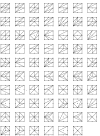A complete classification of epistatic two-locus models
- PMID: 18284682
- PMCID: PMC2289835
- DOI: 10.1186/1471-2156-9-17
A complete classification of epistatic two-locus models
Abstract
Background: The study of epistasis is of great importance in statistical genetics in fields such as linkage and association analysis and QTL mapping. In an effort to classify the types of epistasis in the case of two biallelic loci Li and Reich listed and described all models in the simplest case of 0/1 penetrance values. However, they left open the problem of finding a classification of two-locus models with continuous penetrance values.
Results: We provide a complete classification of biallelic two-locus models. In addition to solving the classification problem for dichotomous trait disease models, our results apply to any instance where real numbers are assigned to genotypes, and provide a complete framework for studying epistasis in QTL data. Our approach is geometric and we show that there are 387 distinct types of two-locus models, which can be reduced to 69 when symmetry between loci and alleles is accounted for. The model types are defined by 86 circuits, which are linear combinations of genotype values, each of which measures a fundamental unit of interaction.
Conclusion: The circuits provide information on epistasis beyond that contained in the additive x additive, additive x dominance, and dominance x dominance interaction terms. We discuss the connection between our classification and standard epistatic models and demonstrate its utility by analyzing a previously published dataset.
Figures







References
-
- Carlborg O, Haley C. Epistasis: too often neglected in complex trait studies? Nat Rev Genet. 2004;5 - PubMed
Publication types
MeSH terms
LinkOut - more resources
Full Text Sources
Other Literature Sources

